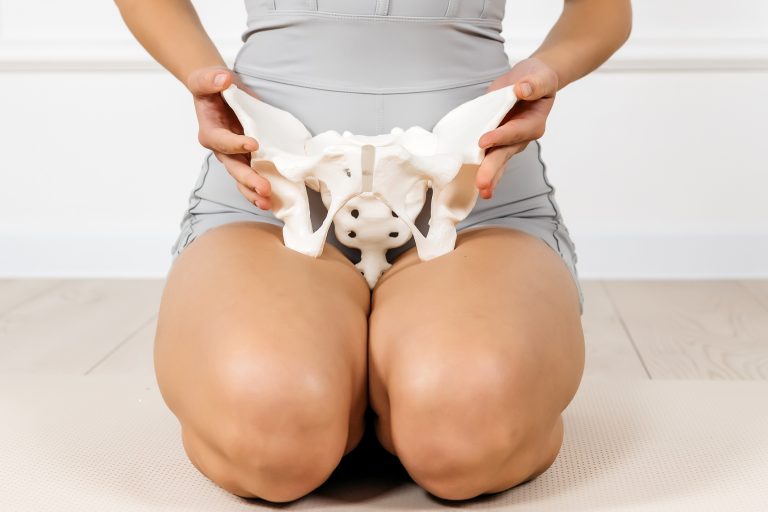This blog was medically reviewed by Brent Dumermuth, MD, obstetrician-gynecologist and regional medical director at Allina Health.
Pregnancy can sometimes cause us to have constipation or urine or stool leakage due to pelvic floor dysfunction. The good news is that this can be treated with pelvic floor therapy. Keep reading to learn more about what is pelvic floor therapy and its benefits.
Pelvic floor therapy has gained popularity for postpartum recovery due to its effectiveness in addressing all kinds of pelvic floor dysfunction symptoms. This form of physical therapy works by targeting our pelvic floor muscles to strengthen and rehabilitate them to relieve symptoms and enhance our overall well-being after pregnancy.

The Mother Baby Center provides support after your baby is born and as your family’s new journey begins.
Understanding the pelvic floor
The pelvic floor is a set of muscles that support the organs in our belly to help control our bladder, bowel, and in women, the uterus. Things like pregnancy, childbirth and aging can make these muscles weaker, which can cause problems like urine leakage or a sagging bladder.
In the case of tighter pelvic floor muscles, it can negatively impact our sexual health by making sexual intercourse painful. To make these muscles stronger or improve pelvic health, many people will opt to work with a physical therapist on pelvic floor rehabilitation therapy.
What is pelvic floor therapy?
Pelvic floor therapy is a specialized approach focused on strengthening, relaxing, or retraining the weak pelvic muscles. Therapists use customized techniques tailored to individual needs and to address specific pelvic floor dysfunction symptoms. This therapy aims to enhance the overall quality of life by restoring the function and strength of these vital muscles, providing significant relief from symptoms and promoting well-being.
Explore our list of postpartum essentials for comfort and care during postpartum recovery.
Benefits of pelvic floor therapy
A common postpartum change that a lot of people experience is weakened pelvic floor muscles that can impact their bladder control or cause pelvic floor spasms. But this is where pelvic physical therapy comes in! It offers numerous benefits and is a great option to explore during postpartum recovery for managing symptoms and promoting long-term pelvic health.
Postpartum recovery
During pregnancy, not only do our pelvic floor muscles have to support the increased weight of our uterus and baby but also get stretched during childbirth – which can lead to pelvic floor disorders. Women that had c-sections may still encounter pelvic floor problems from carrying the baby and especially if they were attempting a vaginal birth first. Seeking pelvic floor treatment during postpartum can help manage and restore pelvic floor health after pregnancy and childbirth.
Symptom relief
Experiencing tight or weak pelvic floor muscles can be hard and frustrating during postpartum recovery, especially on top of everything else new parents have going on during this time. Remember that you’re not alone and there are professionals ready to help guide you through pelvic floor pt (physical therapy) to alleviate common symptoms.
Long-term health
Seeking pelvic floor dysfunction treatment is crucial to the long-term health of our pelvic floor muscles. Pelvic floor dysfunction that gets left untreated can lead to chronic discomfort or even pelvic organ prolapse, a condition where our pelvic organs drop from their original position and cause symptoms such as pelvic and lower back pain, bowel changes, pain during intercourse and more.
Discover support groups for new parents and partners through The Mother Baby Center.
Common conditions treated by pelvic floor therapy
Whether you’re experiencing tight or weak pelvic floor symptoms, therapy can be tailored to your unique needs and address any specific symptoms you have. Below are some common symptoms or conditions that can be treated by pelvic floor therapy.
- Pelvic pain and pelvic organ prolapse. If you’re experiencing pelvic pain and pelvic organ prolapse, therapy can help strengthen your pelvic muscles through exercises to support your organs better and reduce discomfort.
- Urinary and fecal incontinence. This is a common symptom of pelvic floor disorder and through therapy, we can strengthen our pelvic muscles and improve coordination for better control of bladder and rectum.
- Chronic pelvic pain. Whether you’re experiencing symptoms of a tight or weak pelvic floor, working with a physical therapist to create a personalized care plan can help with alleviating and preventing chronic pain symptoms.
- Pain during intercourse or sexual dysfunction. Pain during intercourse can come through lots of different ways. Whether it’s because your pelvic muscles are too tight and need help relaxing or they’re extra sensitive to pain right now, working with a physical therapist can help with decreasing the discomfort.

Learn how The Mother Baby Center provides childbirth recovery support and care.
Pelvic floor therapy: What to expect
During the initial consultation, a physical therapist will conduct a thorough assessment to understand your specific symptoms and goals. This session will involve discussing your medical history, current symptoms and lifestyle factors. Based on this information, you and your physical therapist will work together to create a personalized care plan to address your unique needs.
After the initial consultation, you can expect to have ongoing and regular sessions that will include targeted pelvic floor exercises and techniques to strengthen or relax the pelvic muscles, improve coordination and reduce discomfort. As you continue with the sessions, you can expect adjustments to your care plan depending on the progress you’re making to help you achieve the best outcomes and enhance your overall well-being.
Assessment and diagnosis
For the initial assessment, there should be discussions about the kinds of symptoms you’ve been experiencing and a physical examination. Both types of information can help your therapist find the root cause of your pelvic floor disorder and create a personalized care plan.
Custom pelvic floor physical therapy treatment plan
Depending on the symptoms you’re experiencing, your treatment plan can include any of the following techniques below.
- Targeted exercises. Targeted exercises can help with strengthening and relaxing your pelvic muscles. A popular example is Kegels.
- Manual therapy. This technique involves stretching and massaging the muscles to release tension so they can relax.
- Biofeedback devices. A biofeedback device can give real-time results of how your muscles are contracting and relaxing to see your progress.
- Education on posture and bladder habits. Our posture and bladder habits can also have an impact on our pelvic floor muscles. Depending on your symptoms, changing your bladder habits or posture can be part of your treatment plan.
- Electrical stimulation. Pelvic floor therapy can also include electrical stimulation to help reduce pain and muscle spasms.
Your postpartum recovery journey starts with The Mother Baby Center
When we say we’re committed to partnering with you through your entire journey, we mean it! Our team is ready to support you with your postpartum journey and get you the right resources, guidance and referrals to experts that can help with pelvic floor therapy. For the best and most personalized care during and after childbirth, find a provider and deliver at The Mother Baby Center.